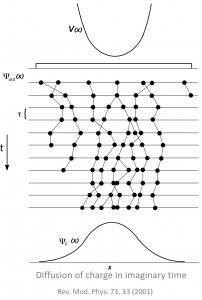The most popular and versatile method for atomic scale quantum mechanical modeling (spanning fields from physics to chemistry to materials science, among many others) is Density Functional Theory (DFT). This approach provides a balance between accuracy and performance by approximating the unknown exchange-correlation energy functional, which describes the complicated interactions between electrons. Under most circumstances, the functionals that have been developed over the past 30 years work sufficiently well to describe a broad range of properties based on the electronic structure of many different materials. However, all of the current DFT functionals fail to model with suitable accuracy the s-to-d or p-to-d orbital charge transfer energies and the strongly localized d and f orbital electrons present in transition-metal atoms, even with semi-empirical corrections. This is most prominent in mixed-valence compounds where the same ion can exhibit different oxidation states. Thus, it is crucial to use other, more accurate approaches in such cases, ones that go “beyond DFT” and can solve the many-body Schrodinger equation in a truly ab-initio (as opposed to empirical) manner. Quantum Monte Carlo is such a method, and it has been applied successfully to a wide range of systems, from atoms to molecules, from solids to liquids to gasses, and from insulators to semiconductors to metals. For many cases, QMC is the only method that can achieve “near chemical” accuracy (within ~1-2 kcal/mole compared to experiments) while being applicable to systems with relatively large numbers (1000s) of electrons. Not only energetics, but also QMC can predict other properties such as electronic, optical, magnetic, mechanical and excited state very accurately.
approach provides a balance between accuracy and performance by approximating the unknown exchange-correlation energy functional, which describes the complicated interactions between electrons. Under most circumstances, the functionals that have been developed over the past 30 years work sufficiently well to describe a broad range of properties based on the electronic structure of many different materials. However, all of the current DFT functionals fail to model with suitable accuracy the s-to-d or p-to-d orbital charge transfer energies and the strongly localized d and f orbital electrons present in transition-metal atoms, even with semi-empirical corrections. This is most prominent in mixed-valence compounds where the same ion can exhibit different oxidation states. Thus, it is crucial to use other, more accurate approaches in such cases, ones that go “beyond DFT” and can solve the many-body Schrodinger equation in a truly ab-initio (as opposed to empirical) manner. Quantum Monte Carlo is such a method, and it has been applied successfully to a wide range of systems, from atoms to molecules, from solids to liquids to gasses, and from insulators to semiconductors to metals. For many cases, QMC is the only method that can achieve “near chemical” accuracy (within ~1-2 kcal/mole compared to experiments) while being applicable to systems with relatively large numbers (1000s) of electrons. Not only energetics, but also QMC can predict other properties such as electronic, optical, magnetic, mechanical and excited state very accurately.
STEAM Lab uses QMC methodology to study accurately predict optical and electronic properties of Two-Dimensional materials, highly correlated systems (superconductivity, magnetic materials, topological materials), molecules (catalyzers for water and CO2 splitting), and Li/Na/B transition metal oxide batteries.